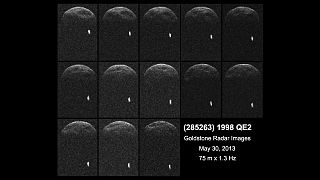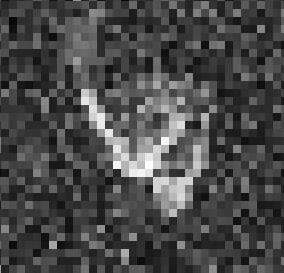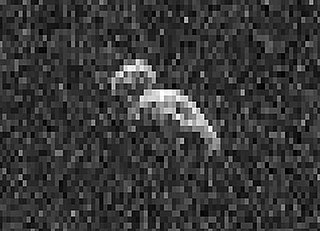Related Research Articles
2063 Bacchus, provisional designation 1977 HB, is a stony asteroid and near-Earth object of the Apollo group, approximately 1 kilometer in diameter. The contact binary was discovered on 24 April 1977, by American astronomer Charles Kowal at the Palomar Observatory in California, United States. It was named after Bacchus from Roman mythology.
5381 Sekhmet is an Aten asteroid whose orbit is sometimes closer to the Sun than the Earth's. Carolyn Shoemaker at Palomar Observatory discovered it on 14 May 1991. It is named after Sekhmet, the Egyptian goddess of war.
4450 Pan is a highly eccentric asteroid and contact binary, classified as a potentially hazardous asteroid and near-Earth object of the Apollo group, approximately 1.1 kilometers in diameter. It was discovered on 25 September 1987, by American astronomers Eugene and Carolyn Shoemaker at Palomar Observatory in California, United States. It was named after Pan from Greek mythology.

(450894) 2008 BT18 is a sub-kilometer asteroid and synchronous binary system, classified as near-Earth object and potentially hazardous asteroid of the Apollo group. It was discovered on 31 January 2008, by the LINEAR program at Lincoln Laboratory's Experimental Test Site near Socorro, New Mexico, United States. The eccentric asteroid measures approximately 600 meters in diameter and has a composition of a basaltic achondrite.
(163364) 2002 OD20 is an asteroid, classified as a near-Earth object and potentially hazardous asteroid of the Apollo group, likely smaller than one kilometer in diameter.
(467336) 2002 LT38, is a sub-kilometer asteroid and suspected tumbler, classified as a near-Earth object and potentially hazardous asteroid of the Aten group, approximately 240 meters (790 ft) in diameter. It was discovered on 12 June 2002, by astronomers of the Lincoln Near-Earth Asteroid Research at the Lincoln Laboratory's Experimental Test Site near Socorro, New Mexico, in the United States.
(7888) 1993 UC is a near-Earth minor planet in the Apollo group. It was discovered by Robert H. McNaught at the Siding Spring Observatory in Coonabarabran, New South Wales, Australia, on 20 October 1993. The asteroid has an observation arc of 23 years and has a well determined orbit. Its estimated size is 2.3 to 5.2 km.
(101869) 1999 MM, provisional designation 1999 MM is a sub-kilometer asteroid on an eccentric orbit, classified as a near-Earth object and potentially hazardous asteroid of the Apollo group. It was discovered on 20 June 1999, by the Lowell Observatory Near-Earth-Object Search (LONEOS) at its U.S. Anderson Mesa Station in Flagstaff, Arizona. The first observation was made by Catalina Sky Survey just 8 days before its official discovery.
(471240) 2011 BT15, provisional designation 2011 BT15, is a stony, sub-kilometer sized asteroid and fast rotator, classified as a near-Earth object and potentially hazardous asteroid of the Apollo group. It had been one of the objects with the highest impact threat on the Palermo Technical Impact Hazard Scale.

(285263) 1998 QE2, provisional designation 1998 QE2, is a dark asteroid and synchronous binary system, classified as near-Earth object and potentially hazardous asteroid of the Amor group, approximately 3 kilometers in diameter. It was discovered on 19 August 1998, by astronomers of the LINEAR program at Lincoln Laboratory's Experimental Test Site near Socorro, New Mexico, in the United States. Its sub-kilometer minor-planet moon was discovered by radar on 30 May 2013.

(192642) 1999 RD32, provisional designation: 1999 RD32, is an asteroid and suspected contact binary on an eccentric orbit, classified as a large near-Earth object and potentially hazardous asteroid of the Apollo group, approximately 5 kilometers (3 miles) in diameter. It was discovered on 8 September 1999, at a magnitude of 18, by astronomers of the LINEAR program using its 1-meter telescope at the Lincoln Laboratory's Experimental Test Site near Socorro, New Mexico, United States. The asteroid is likely of carbonaceous composition and has a rotation period of 17.08 hours.

(388188) 2006 DP14, provisional designation 2006 DP14, is a sub-kilometer sized, peanut-shaped asteroid on a highly eccentric orbit, classified as near-Earth object and potentially hazardous asteroid of the Apollo group. This contact binary was discovered on 23 February 2006, by astronomers of the LINEAR program at the Lincoln Laboratory's Experimental Test Site near Socorro, New Mexico, in the United States. On 10 February 2014, it passed 6.25 lunar distances from Earth. The asteroid is approximately 400 meters in diameter and has a rotation period of 5.77 hours.
(523775) 2014 YB35, provisional designation 2014 YB35, is a stony near-Earth object and potentially hazardous asteroid of the Apollo group, approximately 300 meters (980 feet) in diameter. It was discovered on 27 December 2014 by the Catalina Sky Survey at the Catalina Station in Arizona, United States. In March 2015, a minor-planet moon, less than half the size of its primary, was discovered by radar astronomers at Goldstone Observatory. The primary body of the binary system has a rotation period of 3.3 hours, while the secondary's orbital period remains unknown.

2014 JO25 is a near-Earth asteroid. It was discovered in May 2014 by astronomers at the Catalina Sky Survey near Tucson, Arizona - a project of NASA's NEO (Near Earth Object) Observations Program in collaboration with the University of Arizona.

(190166) 2005 UP156 is a stony asteroid and binary system, classified as near-Earth object of the Apollo group, approximately 1 kilometer in diameter. It was discovered on 31 October 2005, by astronomers of the Spacewatch survey at the Kitt Peak National Observatory in Arizona, United States. Its minor-planet moon with an orbital period of 40.25 hours was discovered in 2017.

(505657) 2014 SR339, provisional designation 2014 SR339, is a dark and elongated asteroid, classified as near-Earth object and potentially hazardous asteroid of the Apollo group, approximately 970 meters (3,200 feet) in diameter. It was discovered on 30 September 2014, by NASA's Wide-field Infrared Survey Explorer telescope (WISE) in Earth's orbit. Closely observed at Goldstone and Arecibo in February 2018, it has a rotation period of 8.7 hours.
(143651) 2003 QO104, provisional designation 2003 QO104, is a stony asteroid, slow rotator and suspected tumbler on a highly eccentric orbit, classified as near-Earth object and potentially hazardous asteroid of the Amor and Apollo group, respectively. It was discovered on 31 August 2003, by astronomers of the Near-Earth Asteroid Tracking program at the Haleakala Observatory in Hawaii, United States. The Q-type asteroid has a rotation period of 114.4 hours and possibly an elongated shape. It measures approximately 2.3 kilometers (1.4 miles) in diameter and belongs the largest potentially hazardous asteroids known to exist.

(164121) 2003 YT1, provisional designation 2003 YT1, is a bright asteroid and synchronous binary system on a highly eccentric orbit, classified as near-Earth object and potentially hazardous asteroid of the Apollo group, approximately 2 kilometers (1.2 miles) in diameter. It was discovered on 18 December 2003, by astronomers with the Catalina Sky Survey at the Catalina Station near Tucson, Arizona, in the United States. The V-type asteroid has a short rotation period of 2.3 hours. Its 210-meter sized minor-planet moon was discovered at Arecibo Observatory in May 2004.
(154276) 2002 SY50, provisional designation 2002 SY50, is a stony asteroid on a highly eccentric orbit, classified as near-Earth object and potentially hazardous asteroid of the Apollo group, approximately 1.1 kilometers (0.7 miles) in diameter. It was discovered on 30 September 2002, by astronomers with the Lincoln Near-Earth Asteroid Research at the Lincoln Laboratory's Experimental Test Site near Socorro, New Mexico, in the United States. The K-type asteroid has a rotation period of 4.8 hours. It will make a close encounter with Earth on 30 October 2071.

2016 AZ8 is a sub-kilometer asteroid and near-Earth object of the Apollo group, at least 400 meters (1,300 feet) in diameter. It was first observed on 3 January 2016, by the WISE telescope with precovery images found back in 2012.
References
- 1 2 3 4 5 6 7 "JPL Small-Body Database Browser: 179806 (2002 TD66)" (2008-04-13 last obs). Jet Propulsion Laboratory . Retrieved 7 April 2016.
- 1 2 3 Dr. Lance A. M. Benner (18 November 2013). "Binary and Ternary near-Earth Asteroids detected by radar". NASA/JPL Asteroid Radar Research. Archived from the original on 8 June 2004. Retrieved 1 March 2014.
- ↑ "Potentially Hazard Asteroids". Archived from the original on 2 February 2002. Retrieved 24 October 2011.
- ↑ "Date/Time Removed". NASA/JPL Near-Earth Object Program Office. Archived from the original on 2 June 2002. Retrieved 24 October 2011.
- 1 2 "JPL Close-Approach Data: 179806 (2002 TD66)" (2008-04-13 last obs). Retrieved 1 November 2006.